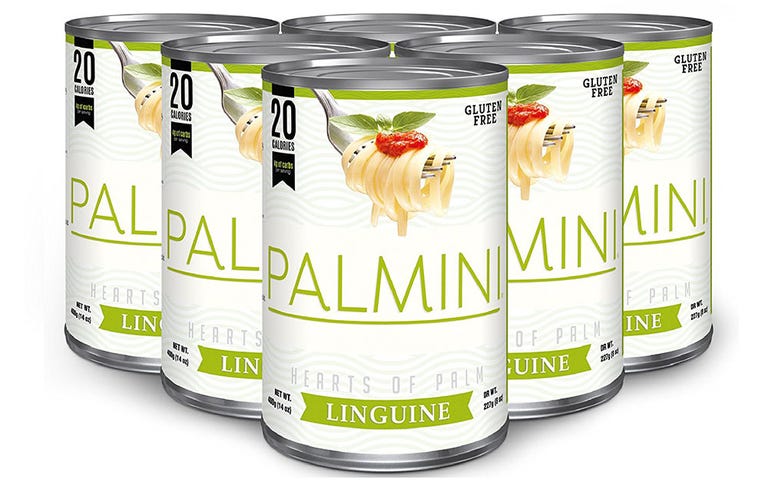
If your keto friend is suddenly Instagramming a million shots of their delicious-looking pasta dinner, you have a right to be confused. Isn’t that breaking the rules? Not necessarily…if they’re eating Palmini.

What is Palmini?
You might look at that packaging and think, “Canned pasta? WTF?”
But Palmini, which was featured on ABC’s Shark Tank in February, comes in a can because it’s a pasta made out of hearts of palm (which, last I checked, are sold in cans). The veggie has been cooked and cut into strands that mimic the shape of a linguine noodle.
And…it looks JUST LIKE regular linguine. Here’s what it looks like fresh out of the can:
A post shared by Robin Williams-Carroll (@robincarroll70) on
And in case you forgot (somehow) what linguine looks like:
A post shared by hashtag #piattitipiciregionali (@piattitipici) on
How is it different from regular pasta?
Your standard dried supermarket pasta is made of semolina and durum wheat flour, while Palmini doesn’t have a single white grain in sight. Think of it like zoodles, says Amy Shapiro, R.D. and founder of Real Nutrition NYC, but made with a different veggie.
And nutritionally, Palmini is pretty different from regular pasta. Here’s what you get in one serving:
Compare that to a one-cup serving of cooked spaghetti:
So with Palmini, you’ll get way fewer calories and carbs, but you’re missing out on a decent chunk of filling protein while getting a lot more sodium (which can cause bloat).
It’s also certified gluten-free, making it a good option for people with Celiac disease or a gluten intolerance.
How should you prepare Palmini?
The one catch with Palmini—it retains the signature smell and taste of hearts of palm. So if you’re not into that…it might not be for you.
However, the makers of Palmini have a simple hack to help: Rinse it once in water to reduce some of its sodium content. Then, soak it in milk (sounds strange, but it apparently helps neutralize the smell) for 15 to 30 minutes. Rinse off the milk, pat dry, and get creative.
How should you eat Palmini?
Eat it just like you would any other pasta, duh. Since it’s already “cooked,” you have the choice to eat it cold from the can or heat it up in the microwave or on the stovetop. Topping it with marinara or pesto sauce are all good options, according to Shapiro. You can also swap it for rice noodles in pad Thai or use it as a base for a stir-fry.
If you need some inspo, check out some of these drool-worthy Instagram posts. It’s pretty impressive how close the Palmini pasta looks to the real thing:
A post shared by Palmini Pasta (@palmini_pasta) on
A post shared by Kerri | B (@ketocoffeechick) on
A post shared by Palmini Pasta (@palmini_pasta) on
Are there any downsides to eating it?
If you stick to a single portion, you should be good to go (we all know how easy it is to overdo it!). However, since it’s high in fiber, Shapiro says it might cause gas and bloating if you eat it in excess.
And if you’re concerned about the environmental impact of eating hearts of palm (which are traditionally not the most sustainable food): According to their website, Palmini says they don’t cut the entire palm tree while harvesting, so it’s agriculturally sustainable. More foodles (that’s fake noodles) for the win.
Is it better than regular pasta?
Since it’s made entirely of a vegetable, and it’s gluten-free, low-calorie, and low-carb, Palmini is a great way to save calories on the base of your pasta and put them toward a little extra sauce or toppings—if that’s what you’re looking for.
But if you’re not, well, “it isn’t better than pasta,” Shapiro says. “It just depends on who you are and your nutritional goals,” she says. “If you’re allergic to wheat or diabetic, then sure, it is better than pasta.”
Of course, nothing will ever be the same as original, gluten-filled pasta. “With Palmini, you have to keep an open mind as the texture may be different, and the smell and flavor isn’t pasta, but it is a good alternative,” says Shapiro.
Source: Read Full Article